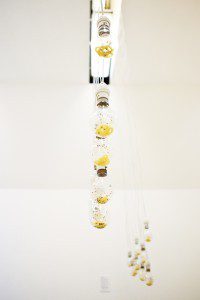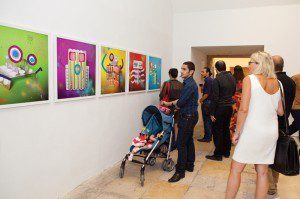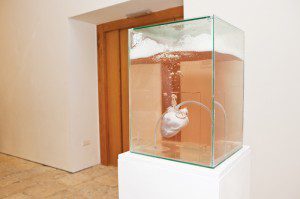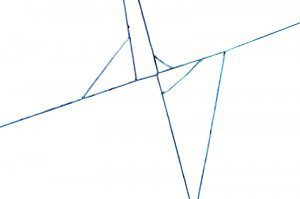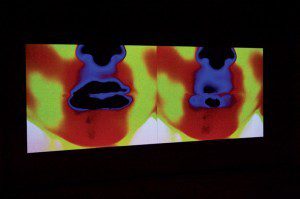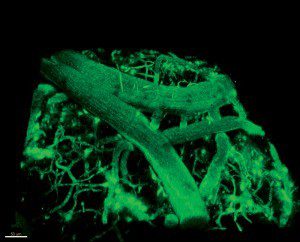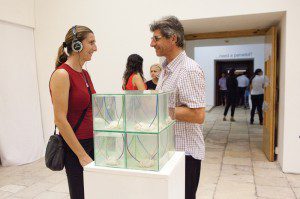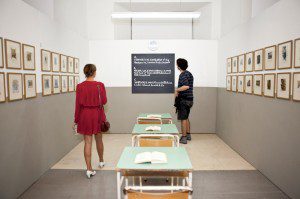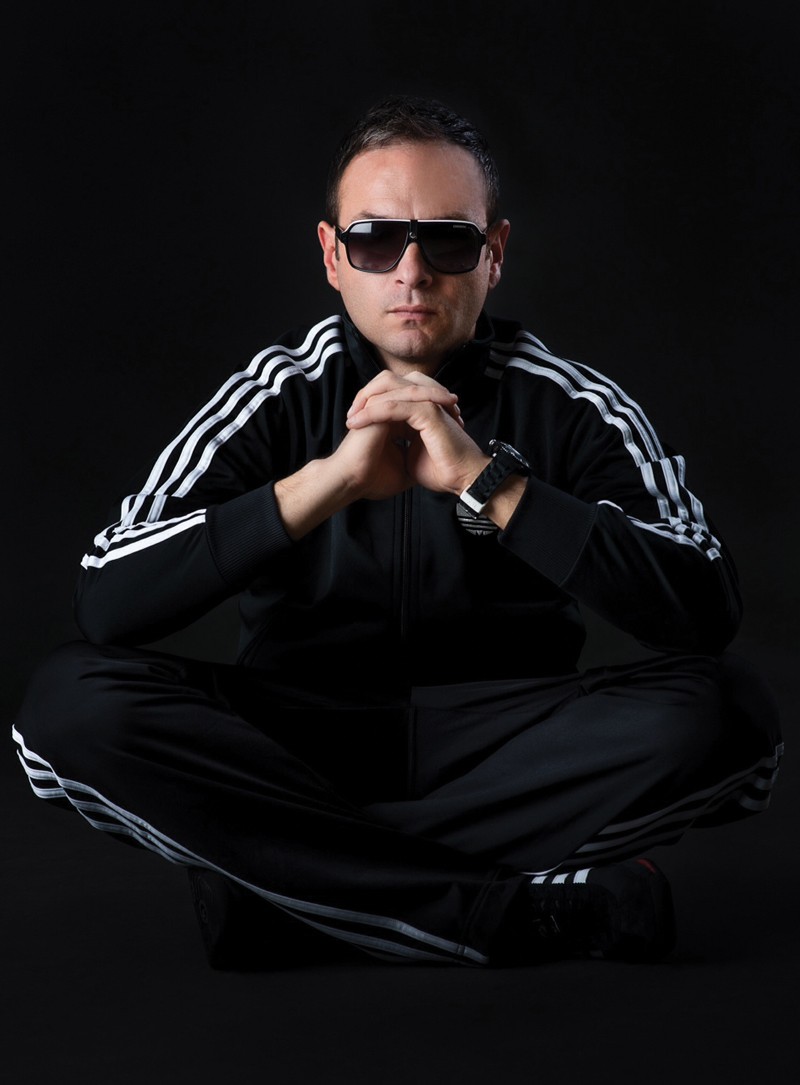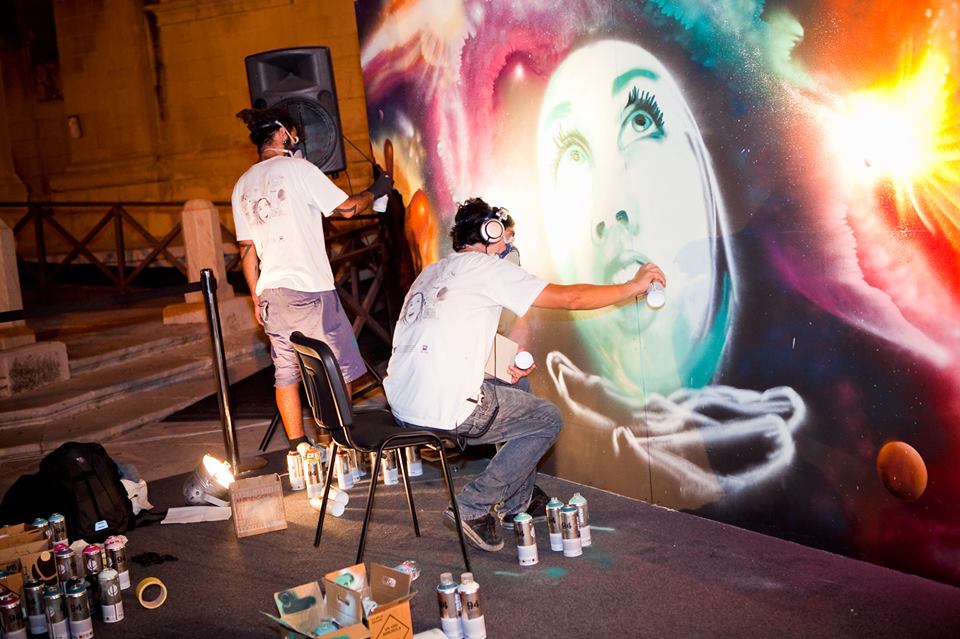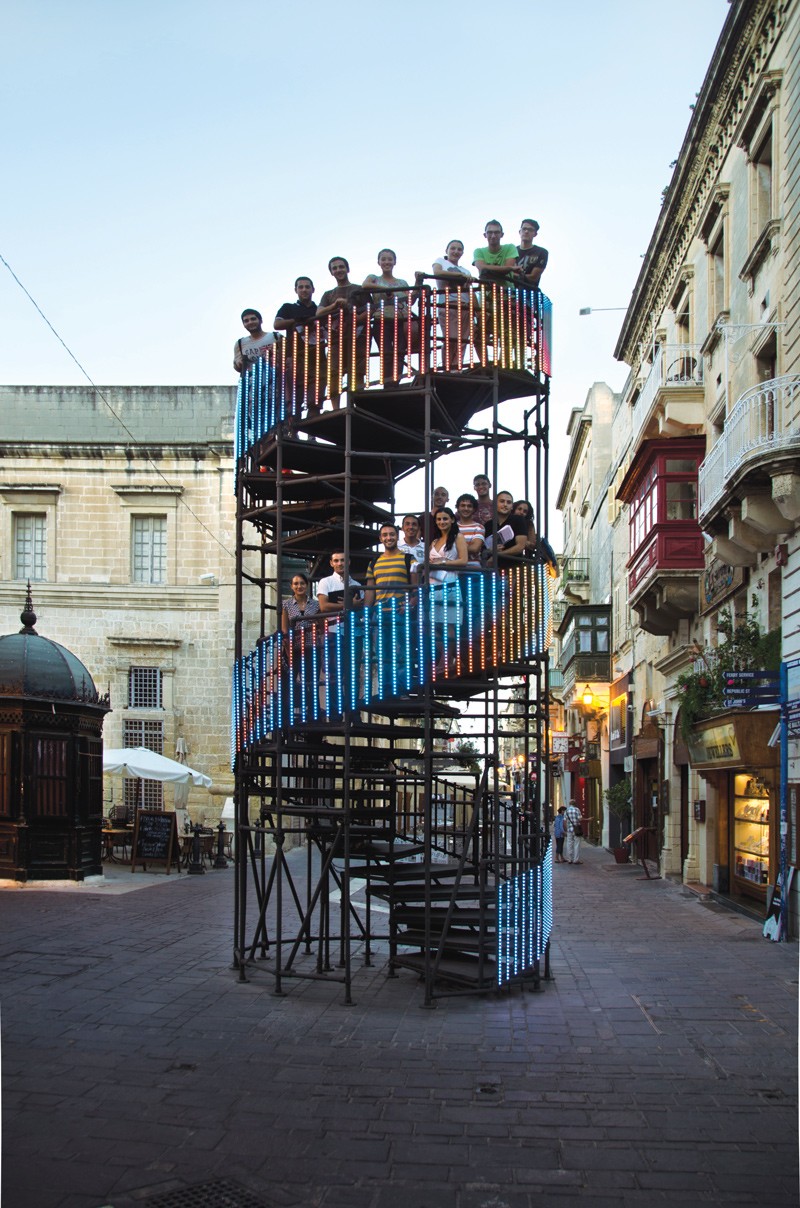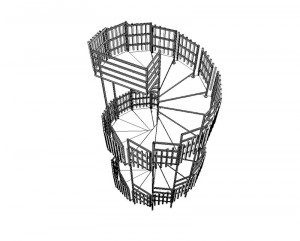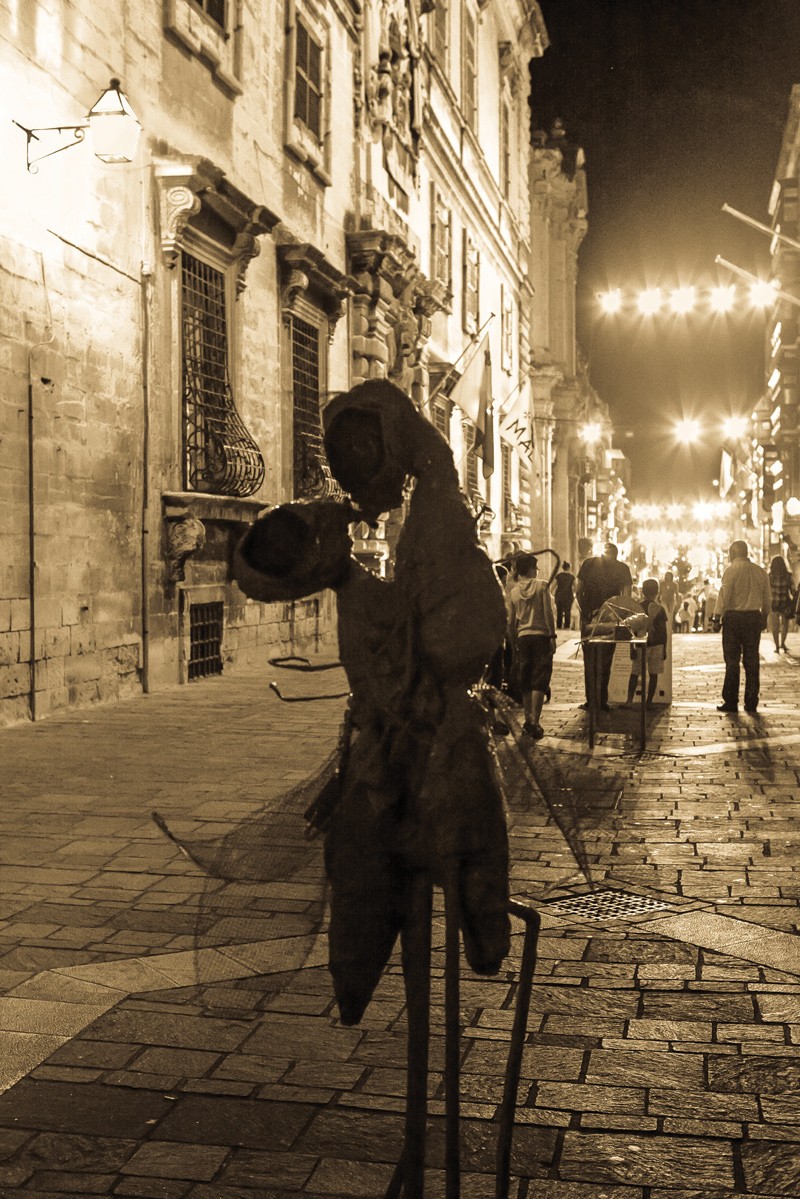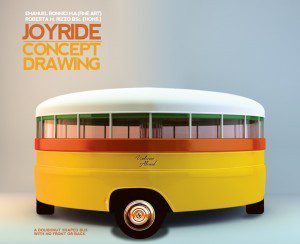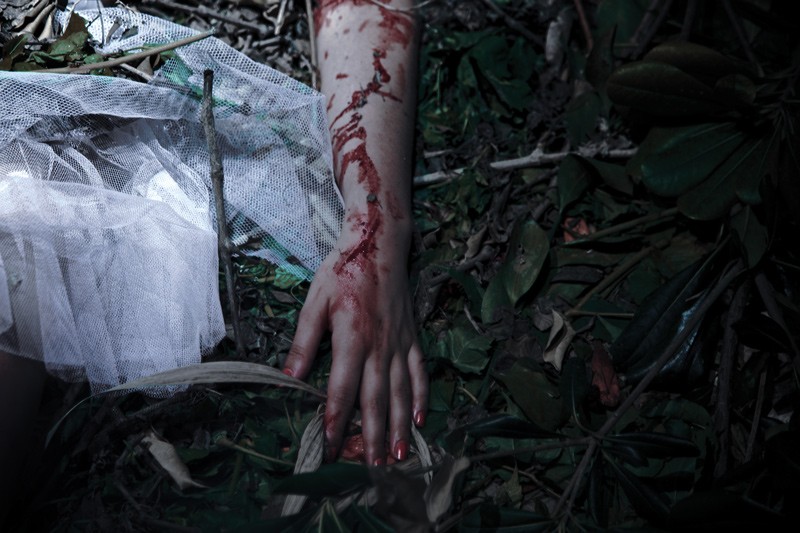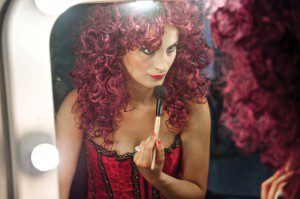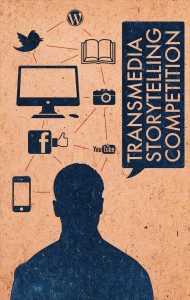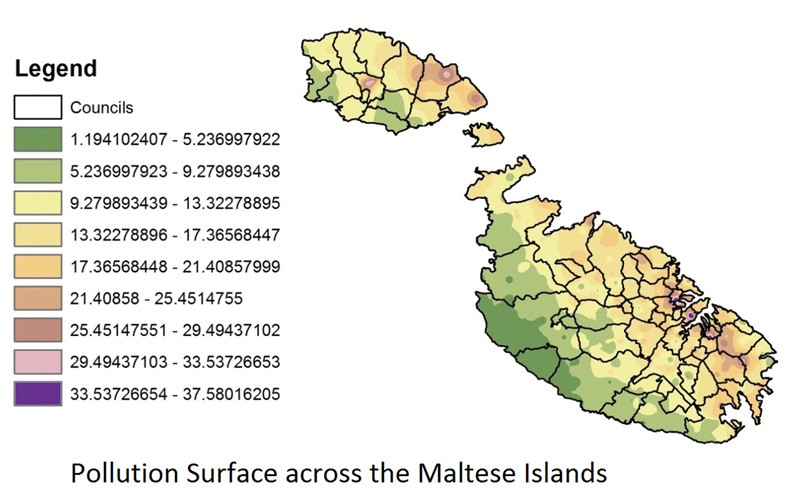HOW?
An interactive exhibition in the upper galleries of St James Cavalier aimed towards adults and children. It ran from the 28th September till the 28th October as part of the Science in the City festival. The exhibition brought science and art together with local artists exploring various scientific phenomena. How does the human mind work? How can a fly be compared to a human or be useful towards the future of the human race? How is a child born with a deformity? How does something stretch but get fatter?…
Each artist reflected on scientific research, and had the opportunity to work with Maltese scientists in their chosen area for inspiration and accurate results.
Exhibition Sponsors: St James Cavalier, Nexos Lighting Technology, Malta Arts Fund
How to get rid of fruit flies?
Sarah Maria Scicluna. Scientists consulted: Dr Edward Duca and Dr Ruben Cauchi who studies muscle wasting diseases using the fruit fly
Fruit flies are commonly viewed as pests by the agricultural industry and in households. Scientists view these insects differently, having studied them for over 100 years. They’ve found out how organs develop, how genes are inherited and learn more about obesity, diabetes and muscle-wasting diseases — these killed Chinese chairman Mao Zedong. At the University of Malta, Dr Ruben Cauchi is studying similar muscle-wasting diseases. Fruit flies share around 70% of human genes that cause disease, allowing scientists to use fruit flies to understand ourselves — an ironic twist.
The fruit flies used for this work were housed in lightbulbs modified to provide them with everything they needed to survive. The flies were flightless mutants, since their genetic code had been altered to stunt their wing growth. The mutation provides irony to its name and renders it unable to survive in the wild.
The techibots
Elisa Von Brockdorff
Say hello to the TechiBots! Technology is a welcome element to contemporary living, yet it can often create a society dependent on it. It can transform man into ‘programmed’ creatures, on which many decisions, procedures and strategies are often based. Systems collapse once technology fails, even momentarily! Agitation and anxiety soar!
Inspired by George Ritzer’s McDonaldization of Society, the TechiBots are constructed out of pill sheets, utilizing the structured material element as a basis for this rampant creature.
O Ye of Little Faith (heart)
Matthew Farrugia
We all need a heart to live. Your body dies within minutes if it stops. The heart is mostly pure muscle, it is around the size of your fist, and located a little to the left in the middle of the chest. The heart’s job is to pump blood around your body to provide oxygen and nutrients.
This responsibility leaves the heart prone to complications. The most common complication is heart failure, which is when it cannot pump enough blood to the rest of the body. Most of the time this is because of a heart attack when blood flow is blocked, which is the most common kind of complication. Other more severe heart diseases include Angina which is when the heart isn’t getting enough blood, giving a severe pain in the chest.
The Human Brain: The only known structure that can study itself
Michael Xuereb. Scientists consulted: Dr Mario Valentino and his team who study the mouse brain
When scientists research, examine, and map the brain, they are using the same organ they are studying. This simple fact is celebrated in Xuereb’s installation. He magnifies a single connection point from the trillions of connections in our brain called ‘connectomics’. Connectomics is used by scientists to project complex brain images. These connections transfer signals and commands that together compute our thoughts. These can be thoughts about what to wear, who we love, mathematical calculations or even reasoning our emotions.
 4.1868: The Theory of Heat
4.1868: The Theory of Heat
Adrian Abela, actors & performers: Tia Rejlić, Martha Vassallo, and Aidan Corlett. Scientists consulted: Prof. Kenneth Camilleri and his team who research biomedical engineering at the University of Malta.
4.1868 discusses various theories of how life began, such as that by Charles Darwin, using both a visible camera and a thermal imaging camera donated for this exhibition by Prof. Kenneth Camilleri and his team at the University of Malta. Adrian Abela interprets the traditional story of Melqart, the God of the Sea and Underworld, through a scientific eye. Thermal imaging cameras are used to diagnose disease and study medical problems. They detect radiation in the infrared range of the electromagnetic spectrum (roughly 9,000–14,000 nanometres or 9–14 µm) and produce images of that radiation, called thermograms.The installation was a 40 minute video.
Brain study 
Scientists consulted: Video by Dr Mario Valentino and Dr Christian Zammit
Dr Mario Valentino (University of Malta) has carried out extensive studies on mouse brains to find out how brain injury occurs and develops in humans. During this research, Dr Valentino captured striking 3D images of mouse brains, which were then displayed in St James Cavalier. The images are mainly focused on mouse vasculature on the surface of the brain and the close association of cells called astrocytes that maintain the blood-brain barrier, which is essential for the survival of neurons.
The Cuckoo’s Nest (brain)
Matthew Farrugia. Scientists consulted: Prof. Giuseppe Di Giovanni and his team, and Dr Neville Vassallo who are studying brain diseases at the University of Malta
The brain is a wonderful organ — what would we be without it?It is able to absorb information and hold memories and keep it stored for years to come. The brain is divided into various parts, all linked and working together. The brain is more complicated than the heart, and is prone to going wrong. Addiction, epilepsy, Huntington’s, Alzheimer’s and Parkinson’s disease, are all illnesses the root of which lies in the brain.
Medical School: How does medicine define the body?
Raphael Vella. Scientists consulted: Textbooks used by medical students at the University of Malta
A series of fifty, small mixed media works were displayed on the walls of a classroom within a room in St James Cavalier, complete with blackboard. The images are photographic transfers on paper, reworked in ink, graphite and additional layers of Chinese paper. This installation of fifty framed, photographic images transports us from the beginnings of the power of medicine over the infant’s body, through the internalisation of medical knowledge via the mechanical components of ‘public health’ policies and systems, and ending with postmortem analyses that conceptualise murder and suicide in the cold language of science.How does medicine define the body? How is the body constructed in the image of medical textbooks? And how does the inaccessibility of medical knowledge to ordinary persons affect their understanding of their own bodies?
From DJ to videographer: Ruby on Science
Lily Agius, the artistic curator of Science in the City met up with DJ Ruby to talk about science and art. Ruby created a video for Science in the City that will be available in 2013 on scienceinthecity.org.mt
– Recently, you progressed from DJ to VJ (video jockey). Was it a hard transition?
No, not really, because it has taken quite a few years to get it in motion. For the past 5 years I have been working with videography on an amateur basis, but all of a sudden at the beginning of this year I decided to take it on professionally, and in a matter of few weeks I learned all that I needed to.
– Which was the art installation or event that you enjoyed the most?
Certainly the live music session by Andrew Alamango and Mario Sammut a.k.a Cynga. It was electronically based, which is my cup of tea.
– One of the exhibits in the exhibition at St James presented fruit flies within their own eco system in bulbs. These organisms are used to investigate muscle-wasting diseases, obesity, cancer, diabetes, and more. Did you ever imagine that humans could be related enough to a fruit fly to use them to learn more about human disease?
I never knew about it before. I was mesmerised to find out at the exhibition at St. James. That was very interesting!
– How did you feel when interacting with the art: climbing the DNA staircase, or entering the echo-proofed room in Strait Street?
It was an amazing experience, not just as a regular person attending the event but also as film maker while on the job.
– Have you ever been to a festival of its kind in Malta or abroad before?
It was a first for me, and was very impressed about how professional the event was.
– Did you expect to see something more from the festival? Is there anything you would like to see at the festival next year?
Well, from my point of view it may be no surprise to hear me say: more music.
– How would you describe the audience of the Science in the City Festival?
People of all ages and from all walks of life were there — it was certainly an event for everyone!
– Do you think that art can be used to explain science?
Yes it can, Science in the City proved that.
– How does science play its part in your own life?
I am very into IT, computers, software, gadgets and electronic music/visual. Technology is all around me and with me everyday, and forever evolving and improving.
Part of Science in the City, Malta’s Science and Arts Festival
For more stories click here
For more information on DJ Ruby: www.pureruby.com or www.facebook.com/djruby. For Ruby’s videography and visual work: www.facebook.com/puremediamalta
Destroying boundaries through Science in the City
Biomedical Ph.D. student Alexandra Fiott (TV show and logistics) shares her thoughts on why the walls between the public and scientists need to come crumbling down.
Climbing your DNA
You are the staircase
Norbert Francis Attard
Scientists consulted:
Prof. Alex Felice
Location: Merchant Street
Sponsors: Nexos Lighting
Technology, Kee-Klamps system, Joseph F. Spiteri and Co. Ltd
Mad About Video Multimedia
Dr Edward Duca talks about a single strand of DNA which transformed Valletta’s streetsContinue reading
Humanised Fruit Flies
Liliana Fleri Soler
Scientists consulted: Dr Edward Duca
Location: Merchant Street,
St James Cavalier, now located in the Biology Department to be permanently exhibited in the new medical wing at the University of Malta
Joyride
Emmanuel Bonnici
Scientists consulted: Roberta M. Rizzo
Location: St George’s Square
Sponsor: St James CavalierContinue reading
THE WIG HUNT
Imagine a crime story told through film, photoshoots, autopsy reports, audio recordings, emails and more — how would you read it? Where would you start? This is the nature of transmedia, taking a universe and spinning from it many stories and subplots. Its an exciting way of telling a story, used to advertise Game of Thrones, the latest Batman movies and the Star Wars franchise. But even a church can be a Transmedia experience with statues, sermons, stained glass, and architecture retelling the Bible’s stories.At this year’s Evening on Campus, Josianne Mamo’s The Wig Hunt entry won the first Transmedia Storytelling Competition ever held in Malta. I managed to meet her just before she left to Scotland.
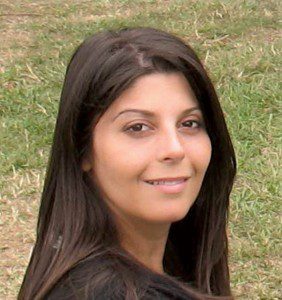
– What is the wig hunt?
The Wig Hunt starts off with a car crash near Loch Lomond (North of Glasgow). In the car they don’t find anyone, just blood. A short distance away they find a brutally murdered and sodomised woman. And, PC James Murray — he’s the investigating officer — is quite new to the business. He’s not really doing well, but he slowly builds his skills as he goes along.
– Is he inexperienced?
He was in a different field, but because of love he changes his career. He moves to Glasgow to be closer to the person he loves, but this move has made the relationship difficult. Probably inspired by my own life. He was in scuba diving before moving into police investigations. He finds the suspect… I shouldn’t be giving too many spoilers. Let’s just say there is another murder and the investigation takes a whole new turn. It’s a story about sex, drugs and crime in Glasgow. I’m trying to take freemasonry as we know it in the Mediterranean and place it in Scotland. Will that be successful? We’ll see.
– Where did the inspiration come from?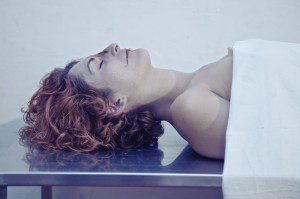
House of Leaves by Mark Z. Danielewski was a major influence in my writing. What’s fascinating about it is the form in which the story is told, which inspired me. My story started off as an exercise in free writing and then it moved from there. The idea was to give bite sized information. I tried to keep the reader going by giving snippets of information then moving on to the next part and the next part and the next part. It fascinates me how a titbit of information grows and becomes never ending. Of course, at the end you need to find a resolution — you need to tame your idea.
– Many of my friends won’t read novels or anything longer than 2000 words.
That’s why I chose this form. The idea was to simulate something that you would find on the internet. Let’s say you found a newspaper article and it got you piqued, and you moved to the next article. It’s like surfing the web and letting those bits of information unfold.
The actual text, simulating official documents (autopsy reports, police reports and so on); a short film on the website; audio clips similar to police investigators talking into a recorder and hearing the conversations as they go along. The idea is not just to give a manuscript but supplementing it with other material.Following the story through different media is what is exciting about it, because it is so different. I moved on and created a website with a timeline where the reader could actually go and read whichever piece of information he wanted, be it the video clip, audio, and you don’t need to read all the titbits. If he’s more interested in the personal relationship then there is another section he can go into. The reader can choose what he wants to read and how to read it.
– What changes did you need to do to make it as a writer in the way you thought of the story to be able to write in a transmedia style? How did you research your novel?
I went there as a writer of historical novels and I ended up writing a crime novel. That went beyond my wildest imagination — it was something major. I had to change in my way of thinking. The fact that I am studying at Glasgow opens various doors. What I did was instead of approaching actual people, I read genuine reports that were leaked online, like David Kelly’s report and various others. I try to go online. My next step is to go to this crime writing festival called Bloody Scotland, which I am very excited about. There will be the likes of Ian Rankin and Denise Mina whom I met at an event at the University of Glasgow. On a whim, I bought the tickets before I started writing the story, now it will be even more exciting. One of the talks will be on how they do research, some people do go all the way and follow police officers and some of them have been police officers, like Karen Campbell was and then she started writing. There are different degrees of involvement.
“It was refreshing for me to write in these different media. That actually helped me in the writing process.”
– You had the likes of Malcolm Galea, and other big names in your photoshoot and film. Why do you think they agreed to get involved?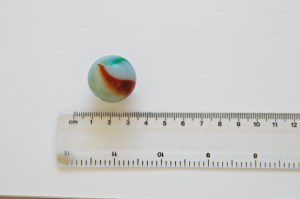
I’m still asking myself that question. Malcolm was a major plus for me. He kept using a word when I was showing him a particular character I wanted him to act out (Val Gina — a transvestite performer), which was ‘fun’. Injecting a bit of humour into my script might have helped get him on board. I always had him in mind for that particular part — it was a major thing for me to get him involved.
-Did you find it hard to write for so many different types of media and why was this a Transmedia story?
More than the writing it was producing it that was very demanding. The challenge was making sure that the tone for each document was right. It was refreshing for me to write in these different media. That actually helped me in the writing process. One big challenge was trying to inject flavour, characterisation, bringing them alive, especially the actual murdered victim. In the crime scene, I tried to strike an emotional chord through the photos. As for the actual investigator, having that subplot going on hopefully makes the character three-dimensional.
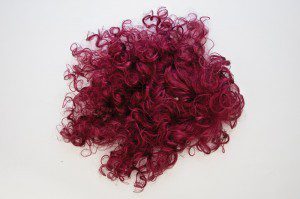 – What does Transmedia bring to storytelling?
– What does Transmedia bring to storytelling?
I would say that it adds richness. Telling a story is challenging. As a writer you have a picture in your mind and
you have to place it in words. Showing that picture that you have to the reader
is exciting and a writer of a traditional manuscript would have to transmit that only through words. In my case I am doing this with various different means, photos, audio clips, so people can hear the suspect speaking. The challenge was to link all this together to make sure that there are no loose ends.
Perhaps this might inspire next year’s participants: “It is a fantastic opportunity to be working on something you really love and winning this transmedia competition means I’ll have even more time to work on this project,” said Josianne Mamo. “You learn so much by doing something different. And, I loved it,” she said

The other participants:
| How it all started |
|
Every story has a beginning. This competition was inspired by a BBC TV programme which highlighted the Transmedia approach of telling stories. After watching this, Patricia Camilleri got her team hooked onto the idea, at the same time as Jean Pierre Magro was organising the first Transmedia seminar in Malta. The rest, as they say, is history. This year there were six entries. Daphne Kelleher, the event’s organiser said, “I was intrigued by the stories […] I wanted to see them visually and what they could come up with, […] they captured the imagination”. Josianne Mamo’s entry was the one which gave the most various and well prepared media. For next year, Daphne suggests, “Go into what you know and use it in detail, be enthusiastic and form a team with people who have different skills.” Transmedia uses different media, but instead of having one storyline, build a universe and from it draw many stories. To be continued… new competition launched in March 2012, see: |
– ANGELUS
Simon Theuma, Gabriel Borg, Mark-Anthony Fenech & Jean-Luc Portelli
Post-war 1950’s. A new city has sprung up in the desert where life is dictated by God. You are wellcome as long as you have God in your heart, but what does that mean?
Media: an Alternate Reality Game, Novels, Live Events, Comics, TV Series, Webisodes, Podcasts/Radio, Newspapers, Augmented Reality, web-based role playing game (MMORPG), Twitter and Facebook.
– CYBER SECRETS
Daniela Azzopardi, Marta Vella & Graziana Agius
The University of Malta’s Media Faculty blog has been hacked and secrets… dark secrets… are being exposed. The shameful side of lecturers and students are being exposed. Everyone has a secret — whose will be next?
Media: blogs, online forum, mobile app, TV series, and novellas.
– DREAMS OF THE UNDESERVING
Ivan Xuereb
Insomnia! Everyone can suffer from it, but just imagine if you never slept. This is the Sandman’s fate. He offers people the chance to have their dreams… at the expense of others.
Media: website, blogs, Vimeo, YouTube, Facebook, Twitter, Physical Installation, and Graphic Novel.
– THE DARK
Jean-Marc Chapelle & Karl Xuereb
In Malta a secretive research company called Obertek finds a dome under Mdina. Inside it they find an artefact which has extraordinary powers but after a failed experiment the artefact vanishes. The dome’s carvings hold a mystery that must be solved to reclaim the artefact.
Media: website, TV series, Facebook, Twitter, YouTube, videogame, mobile app, email newsletter, QR codes.
– THE UNDERDOGS
Neil Attard & Valentina Cassar
Coming from a difficult background Donovan finds it difficult to succeed. He has problems with work, colleagues and his girlfriend. After meeting a stranger in a bar, he is darkly reborn and seeks revenge on his employers.
Media: webisodes, film, comics, game, website, television, other promotional media.
Brain Awareness, Research and Facts
Prof. Giuseppe Di GiovanniContinue reading
Bad traffic, bad air
Air pollution is one of Malta’s greatest concerns. Transportation is the principal source with over 300,000 vehicles belching out smoke, which damages our environment and health. Emissions from vehicles need to be monitored and controlled, and the information used to improve the current system and ensure an acceptable air quality.
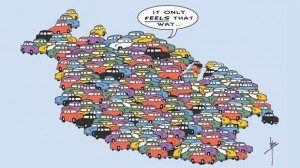
In Malta, air pollution levels are monitored by MEPA (Malta Environment and Planning Authority). MEPA has 131 diffusion tubes that take monthly measurements of air pollution levels. The pollution data set used ranges from 2004 to 2011. On the other hand, Transport Malta (TM) measures traffic flow along the main arterial roads. By using the pollution data set, Nicolette Formosa (supervised by Dr Kenneth Scerri) mapped the air pollution levels and major sources around Malta.
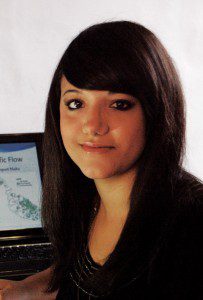
MEPA and TM take measurements at different locations. To overcome this problem, the pollution data set needed to be interpolated to extend over the whole of Malta. By interpolating the pollution measurements using mathematical models, traffic and pollution levels can be directly compared.
Malta was divided into four zones. The Grand Harbour area had the strongest link between traffic and pollution. The central area has a strong overlap but this decreased on Saturday and more so on Sunday. The north and south parts of Malta experienced lower levels over weekends. However, the northern area has a stronger link during weekdays. The areas of Floriana and St Julian’s had a remarkable link between pollution and traffic, lighting a red bulb marking priority areas for the authorities to tackle.Overall, Malta’s air pollution problems are interwoven with its traffic volume. This highlights a problem which needs both scientific and political measures to tackle. Formosa’s studies need to be taken a step further, “there needs to be a statistical means to interpret the data of air pollution measured against traffic flows in the same areas“ said Hon. George Pullicino, Minister for Resources and Rural Affairs. If implemented, the research could help lower health care costs in Malta while improving the quality of life.
This research was performed as part of a Bachelor of Electrical Engineering (Honours) at the Faculty of Engineering.



